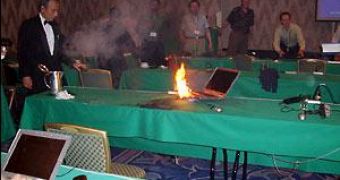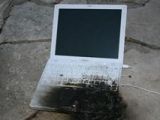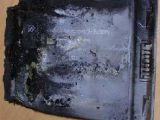Shortage and price rise are predicted
Global recall of about 8 million Sony Corp. notebook-computer batteries is creating a shortage that's driving up prices and causing delays in shipments, executives from three Taiwanese manufacturers said and were quoted by Bloomberg.
The shortfall may last until next June and customers are waiting an extra two months for shipments, said managers at Gentle Wayeer Electric, ETI Pack and Nexcell Battery, which make packs from cells supplied by Tokyo-based Sony and competitors such as Sanyo Electric.
"It's very critical now, not just for notebook computers but every other application", said Peter Hsueh, a general manager at Taipei-based Gentle Wayeer. Rival battery makers including Sanyo and Samsung don't have the capacity to fill the orders, the executives said. A typical one-month wait for shipments is taking three months. Four to eight cells are used in one notebook battery.
"We cannot comment on the details at this time. We will make further updates available", said Shigenori Yoshida, a Sony spokesman in Tokyo.
"If we ask for small amounts, we might be able to get supply, but if we order large amounts of more than 2,000 cells then you can forget about it", said Eric Lai, manager at Hsinchu, Taiwan-based Nexcell Battery.
Effects
The number of Sony-made batteries being replaced is 8 million since August.
Prices for battery cells have risen about 15 percent in the past three months because of the shortage, the three Taiwanese battery makers said. More increases may come this quarter, according to Cheng Uei Precision Industry Co., which supplies notebook batteries to Sony, Dell and Hewlett-Packard.
"Prices will increase around 10 percent in the fourth quarter", said Linda Ho, a sales manager at Taipei-based Cheng Uei. The company is facing a shortage of battery cells, she said, without giving details.
Sony is destroying 43 million cells as part of the recall, said Eric Yu, a Taipei-based manager at ETI Pack, indicating a disposal of as many as 10.8 million batteries. He's been asked by suppliers to accept higher prices on previously ordered batteries. And that's a theft if you ask me, because nothing of this sort should apply retroactively.
"If I say no to a price rise, maybe there will be no supply next month", ETI's Yu said. And if you say yes, many people will still buy them, so you will find yourself in the same situation, I might add, with the single difference that you will make more money. Would you prefer to have a stock when the demand is high, or to seize the moment and impose a price rise? Obviously, they think people will buy more expensive batteries just because they need them, and the shortage will be inherent anyway.
Sanyo, based in Osaka, made 42 million battery cells a month last quarter, while Sony manufactured 27 million, according to the Institute of Information Technology in Japan. Samsung, the third-largest producer, made 26 million cells a month, according to the estimates.
Companies Involved
Dell, Apple, HP and Lenovo have gathered in San Jose, California, to set new manufacturing and specification standards for notebook and handheld devices batteries. All the upper mentioned companies are part of the OEM Critical Components Committee of the IPC-Association Connecting Electronics Industries and have co-developed in the past other critical standards for the industry.
"Standards make things easier on suppliers because they have one set of preferences for how effectively a thing is supposed to perform, it takes you out of the realm of every company having its own individual specification. You also end up with something where there's a lot more technical expertise going into it because you'll have the experience of more than one company participating in making the standard," said IPC, an association connecting electronics industries, through vice president of marketing and communications Kimberly Sterling.
Previously, all the dedicated makers and the ones that just use the batteries for their devices were somehow unwilling to set "universal battery standards" because then they wouldn't have the patent over the new developed standards. "I think things got in the way, like fear of IP (intellectual property). We've just got to realize that we're not talking about IP, we're talking about process control," said John Grosso, Dell's director of supplier engineering and quality, cited by X-bit Labs.
Sony hasn't named all the computer makers that may be using defective batteries that can cause laptops to catch fire, and left for them the possibility to voluntarily join the replacement program.
Not all the firms are willing to do that. For example, HP said it has decided it is not necessary for the company to join the global battery replacement program that Sony has announced to address safety issues. This was announced after reviewing, along with Sony, battery cells used in HP notebooks.
"Based on this review, the companies are confident that because of HP's PC system configuration, HP notebooks using Sony battery cells are not prone to overheating issues that have recently been observed", the two companies said in a joint statement. HP said, to date, it has not received reports of overheating in any HP notebook using Sony battery cells included in the global replacement program announced by Sony a few days ago.
"After discussing the issues with Sony, we believe that we have the proper charging and circuit protections in place to prevent an overheating episode. While no battery is immune to failure or overheating, battery solutions provided by HP are unique and are designed with a number of HP engineered safety features that are in addition to what is typical in the industry", said Ted Clark, senior vice president and general manager of HP's notebook business unit.
Also, According to Rick Clancy, a spokesman for Sony Electronics, cited by Daily Tech, there were only two reported incidents which involved Vaio notebooks and the batteries were some fake ones. "As far as Vaio PCs are concerned we don't anticipate any need for a recall, and that's true from our understanding of other manufacturers we supply this technology to as well...there's no indication that there's an excessive number of situations that have occurred that would warrant this type of action."
For now, the following companies joined the recall: Hitachi, Lenovo/IBM, Dell, Toshiba, Fujitsu, Apple. Matsushita also recalled batteries due to fire hazard but refused to disclose the maker of the products.
For Hitachi, the recall covers only Japan, because the company does not sell laptops overseas. The battery packs were installed in the company's Flora 210W and Flora Se210 laptop personal computers for the Japanese market, said Hitachi's spokesman Masahiro Takahashi.
From Lenovo, the recalled products were sold (with or separately) to be used the following ThinkPad notebooks: T Series (T43, T43p, T60); R Series (R51e, R52, R60, R60e); X Series (X60, X60s). Consumers should contact Lenovo at (800) 426-7378 to determine if the battery is part of the recall.
Toshiba spokesman Keisuke Omori said the recall was in response to Sony's request, and Toshiba hadn't found any cases in which the laptops were at risk of catching fire, and they just wanted to assure and satisfy the customers.
"The company is setting aside as much as 30 billion yen ($251 million) for costs related to the August recall of batteries used in Dell and Apple computers", declared Sony spokesman Yoshikazu Ochiai. He declined to comment on the costs for the other recalls, or confirm how many batteries Sony makes.
"We originally bought 30 percent of our battery cells from Sony but have lowered that to almost zero because of quality concerns", said J.D. Chen, a sales manager at Celxpert Energy, a Taiwanese battery supplier to companies including Hewlett-Packard and Acer.
The recall has helped LG Chem, South Korea's largest battery maker, gain additional orders, said spokeswoman Tracey Park in Seoul, without providing details.
Related stories
On the funny side if that's even possible, I was telling you that the U.S. CPSC (Consumer Product Safety Commission), charged with protecting the public from unreasonable risks of serious injury or death from more than 15,000 types of consumer products under the agency's jurisdiction said that deaths, injuries and property damage from consumer product incidents cost the nation more than $700 billion annually. They released a "guide" on how to handle batteries.
First of all, the user should be aware that at least 47 incidents were reported. On the list of things you do NOT want to do:
- Do not use incompatible computer batteries and chargers. If unsure about whether a replacement battery or charger is compatible or not, contact the product manufacturer.
- Computer batteries can get hot during normal use. Do not use your computer on your lap!
- Do not use your computer on soft surfaces, such as a sofa, bed or carpet, because it can restrict airflow and cause overheating.
- Do not permit a loose battery to come in contact with metal objects, such as coins, keys or jewelry.
- Do not crush, puncture or put a high degree of pressure on the battery as this can cause an internal short-circuit, resulting in overheating.
- Avoid dropping or bumping the computer. Dropping it, especially on a hard surface, can potentially cause damage to the computer and battery. If you suspect damage, contact the manufacturer.
- Do not place the computer in areas that may get very hot.
- Do not get your computer or battery wet. Even though they will dry and appear to operate normally, the circuitry could slowly corrode and pose a safety hazard.
This guide is a bit like... "use your left hand, not your right one, to scratch your left ear" or "to walk, move your legs", but I guess there must be at least a few people who can find it useful, so something like this can never hurt.
Another tragic-comical incident took place when Yahoo's offices in Santa Clara caught fire after a Dell computer exploded at the eighth floor. All workers were evacuated after the smoke alarms went off.
This was as a surprise, as the company hardware is composed mostly of HPs and MACs, and it is believed the flaming Dell was personal property, and wasn't supposed to be in the building in the first place. Sony batteries did it again, according to Flickr photographer, Stewart Butterfield.
Cameron Marlow, an employee and an eye-witness, declared: "Looked up - smoke. Fire alarm going off. Got up and walked downstairs. That was it. The surprising thing is that it was a Dell, and pretty much all of Yahoo is on HP. It was in the research area. Most people were confused, thinking it was a false alarm, until they saw the laptop. [...] they stood around and waited. No surprise really. Pretty much like a school fire drill."
"We stood around or sat in the sunshine. It was a perfect time to grab lunch. Anyway, fire engine shows up. Turns out someone's DELL had caught fire up on the 8th floor. The fireman took it outside, hence the photos. Possibility some people suffered smoke inhalation", said another Yahoo worker.
Possible causes
The major cause of the recent Sony battery recall has not been revealed, but passive component makers suspect that cracking of the multi-layer ceramic capacitors (MLCCs) or the inappropriate use of negative temperature coefficient (NTC) resistors caused the batteries to overheat, according to Digitimes.
Comments were made and it seems that overheating may have originated in the electrical insulation of the batteries and that MLCC and other passive components should not be the major cause of the incident. Some Taiwan-based makers suspect that the adopted MLCCs had been cracked by printed circuit board (PCB) assembly, and that this may have caused an unstable flow of current, leading eventually to overheating.
Most of the MLCCs that had been found to be cracked had been made using X7R material, and X7R-based MLCCs are widely employed in applications that require a relatively high current. In order to avoid cracking, some makers introduce a so-called "open mode design," which adjusts the design of the MLCC electrode. The US-based Kemet and Taiwan-based Walsin Technology have both introduced this kind of design. Some industry players add organic materials to MLCCs, to avoid cracking. They usually term this type of supplementation of organic materials, "soft termination"or "polymer termination." Industry players that include the UK-based Syfer and Avx/Kyocera have introduced this type of solution.
The inappropriate adoption or lack of NTC resistors may also lead to overheating problems, said some Taiwan players. Since NTC resistors play a critical role in terminating the power supply, when overheating is detected, the inappropriate use or lack of NTC resistors may also have the effect of causing overheating.
While Sony agreed that battery failures reflect a manufacturing flaw in the battery cells it supplies, it also continued to say that the problem was at least partly caused by the laptops themselves. "The risk of fire can be affected by variations in the system configurations found in different notebooks". To be more precise
Sony said in an official statement that the recall arises because, on rare occasions, microscopic metal particles in the recalled battery cells may come into contact with other parts of the battery cell, leading to a short circuit within the cell. Typically, a battery pack will simply power off when a cell short circuit occurs. However, under certain rare conditions, an internal short circuit may lead to cell overheating and potentially flames, the company indicated. The potential for this to occur can be affected by variations in the system configurations found in different notebook computers.
To sustain that, Sony's own internal investigation revealed, after intensive testing, that the company engineers had not been able to reproduce any battery failures themselves, suggesting that the cause may lie partly in the systems designs.
Sony executives were informed about a Dell notebook that caught fire in November last year, after its engineers were sent to have a look and reported the battery was prone to overheat because of the contamination with metal particles during the battery's production process, said a local (Japanese) newspaper, the Yomiuri Shimbun.
The electronics giant learned in December that a Dell notebook computer caught fire in November and it was fitted with one of Sony's batteries, said the same newspaper. Sony then concluded that the battery was prone to overheating and that the reason for the overheating was metal particles that had contaminated the battery during the production process.
The production process was corrected immediately upon discovering the problem, but Sony only examined the same type of batteries produced around the same time. Sony did not examine batteries it had produced for companies other than Dell on the ground that no accidents had been reported in other computers. Sony also did not thoroughly examine the electrical circuits and other hardware used in Dell PCs. The November incident was reported to other PC makers, telling them what the cause was and the fact that Dell had carried out a recall, but it did not request other makers to recall Sony batteries.
After other cases of fire involving Dell PCs were reported this summer, Sony examined its batteries again. "Due to the combination of PC hardware (in Dell Pcs), our batteries could start a fire. We concluded that no further problems were likely to occur at the time of Dell's December recall, but we failed to examine the hardware used in Dell Pcs", said a spokesman from Sony.
Conclusion
Almost a year passed and the problems only grew for Sony, and the future doesn't look that great either. Leaving aside the money loss, the main problem is trust. It's hard to gain that once it is lost, and it seems the company will see that on its own skin. And the fact that some people are trying to fill their pockets using the circumstances doesn't help either.
In the end, the users can only hope that companies will learn from the whole affair, and this kind of things will never happen again.

 14 DAY TRIAL //
14 DAY TRIAL // 




